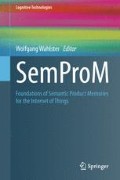Abstract
Auto ID technologies based on RFID, 2D matrix codes, and barcodes allow identification not only of product types but also objects at item level. Information acquired along the product lifecycle can consequently be associated to items. The acquired data can be stored either at the item itself on product-embedded storage or remotely, for example, on a server. As current RFID tags cannot store all relevant data due to the limited space, a solution is required to store product information remotely, providing access for all relevant lifecycle actors.
This chapter provides an overview of selected approaches to related distributed information management for that purpose. The focus is on managing information on products throughout the entire product lifecycle. Peer-to-Peer (P2P) networks are identified to be a promising solution. So P2P networks become a scalable option to flexibly store and distribute product information and are particularly considered.
A second challenge for the storage, organization, and retrieval of Digital Product Memories (DPMs) are composite products that contain subcomponents with their own DPMs, e.g., cars and manufacturing plants. We present a simple and general model for the structure of products with several DPMs that is independent of the considered product, domain, application, and company. It provides a standardized basis to distribute and query the data of subcomponents. The model also supports composite DPMs, where a DPM can store the information of its subcomponents.
Access this chapter
Tax calculation will be finalised at checkout
Purchases are for personal use only
Notes
- 1.
We use the general term “object” for items, products, their components, subcomponents, etc.
- 2.
We use the term “model” to cover model languages, data formats, and specifications as well as the model instances expressed therein.
- 3.
The primary ID is analogous to the DB concept of primary key.
- 4.
- 5.
An internationalized version would use connection point IDs and localized names.
- 6.
Compare with interface in CAEX (International Electrotechnical Commission 2008), which is a typed connection point.
- 7.
This corresponds to a component as defined in Bittner and Donnelly (2005).
- 8.
- 9.
References
T. Bittner, M. Donnelly, Computational ontologies of parthood, componenthood, and containment, in IJCAI-05, Edinburgh, Scotland, July–August, ed. by L.P. Kaelbling, A. Saffiotti (Professional Book Center, Denver, 2005), pp. 382–387
S. Horn, A. Claus, J. Neidig, B. Kiesel, T. Hansen, J. Haupert, The SemProM data format, in SemProM—Foundations of Semantic Product Memories for the Internet of Things, ed. by W. Wahlster. Cognitive Technologies (Springer, Berlin, 2013)
International Electrotechnical Commission, Representation of Process Control Engineering—Requests in P&I Diagrams and Data Exchange Between P&ID Tools and PCE-CAE Tools. http://www.iec.ch/, 2008
International Standard, IEC 61360—Standard Data Elements Types with Associated Classification Scheme for Electric Items. http://www.iec-normen.de/, July 2009
International Organization for Standardization, Information Technology—Automatic Identification and Data Capture Techniques—QR Code 2005 Bar Code Symbology Specification. ISO Standards (ISO/IEC 18004:2006), 2006. http://www.iso.org/iso/iso_catalogue/catalogue_tc/catalogue_detail.htm?csnumber=43655
International Organization for Standardization, Industrial Automation Systems and Integration. ISO Standard (ISO 13584), 2010. http://www.iso.org/iso/iso_catalogue/catalogue_ics/catalogue_detail_ics.htm?csnumber=43423
B. Kiesel, J. Neidig, The block interface: accessing digital product memories, in SemProM—Foundations of Semantic Product Memories for the Internet of Things, ed. by W. Wahlster. Cognitive Technologies (Springer, Berlin, 2013)
E.K. Lua, J. Crowcroft, M. Pias, R. Sharma, S. Lim, A survey and comparison of peer-to-peer overlay network schemes. IEEE Commun. Surv. Tutor. 7, 72–93 (2005)
Network Working Group, URL—Uniform Resource Locators. http://www.ietf.org/rfc/rfc1738.txt, 1994
OMG—Object Management Group, UML—Unified Modeling Language. http://www.omg.org/spec/UML/, 2012
A. Pförtner, Analysis of solutions for decentralized access to distributed product lifecycle information in business environments. Diploma thesis, TU Berlin, Berlin, Germany, December 2010
N. Schoenemann, K. Fischbach, D. Schoder, P2P architecture for ubiquitous supply chain systems, in 17th European Conference on Information Systems (ECIS’09) (2009)
S. Shrestha, D.S. Kim, S. Lee, J.S. Park, A peer-to-peer RFID resolution framework for supply chain network, in Second International Conference on Future Networks (ICFN ’10), Sanya, Hainan, January (2010), pp. 318–322
STEP Tools, Inc. ISO 10303: STEP—Standard for the Exchange of Product Model Data; Industrial Automation Systems and Integration. www.steptool.com, 2009
Tag Data and Translation Standard Work Group, EPCTM Tag Data Standards Version 1.4. Technical report, EPCglobal Inc., June 2008. http://www.epcglobalinc.org/standards/tds/tds_1_4-standard-20080611.pdf
Q.H. Vu, M. Lupu, B.C. Ooi, Peer-to-Peer Computing: Principles and Applications, vol. 1 (Springer, Berlin, 2009)
W. Wahlster (ed.), SemProM—Foundations of Semantic Product Memories for the Internet of Things. Cognitive Technologies (Springer, Berlin, 2013)
Author information
Authors and Affiliations
Corresponding author
Editor information
Editors and Affiliations
Rights and permissions
Copyright information
© 2013 Springer-Verlag Berlin Heidelberg
About this chapter
Cite this chapter
Horn, S., Schennerlein, B., Pförtner, A., Hansen, T. (2013). Distributed Digital Product Memories. In: Wahlster, W. (eds) SemProM. Cognitive Technologies. Springer, Berlin, Heidelberg. https://doi.org/10.1007/978-3-642-37377-0_13
Download citation
DOI: https://doi.org/10.1007/978-3-642-37377-0_13
Publisher Name: Springer, Berlin, Heidelberg
Print ISBN: 978-3-642-37376-3
Online ISBN: 978-3-642-37377-0
eBook Packages: Computer ScienceComputer Science (R0)

